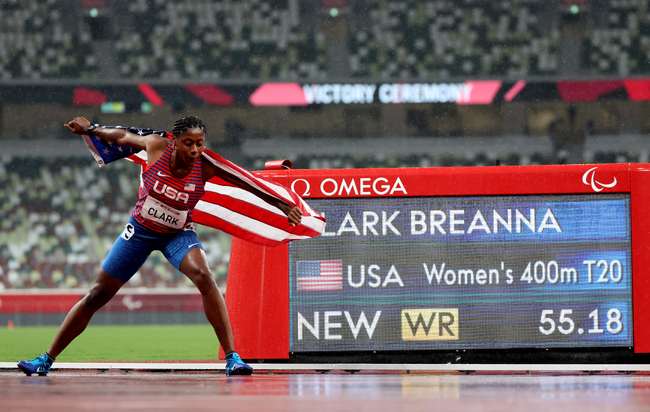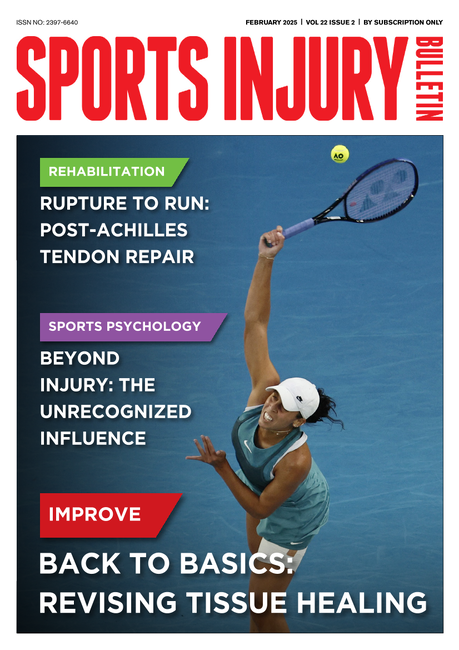You are viewing 1 of your 1 free articles
Unleashing the Potential: Safeguarding Neurodiverse Athletes from Injury Risks
Neurodiversity, the concept that recognizes and celebrates the natural variations in human brain functioning, may influence the risk of sports-related injuries in individuals. Marianke van der Merwe uncovers the injury risks and provides practitioners with guidelines to unleash the potential of neurodiverse athletes.
Women’s 100m - T20 Final - Olympic Stadium, Tokyo, Japan. Breanna Clark of the United States celebrates winning the race and setting a new world record. REUTERS/Bernadett Szabo
Neurodiversity refers to the difference in behavioral traits and brain function of individuals. Stated simply: they are ‘wired’ differently, not wrong(1). Conditions such as attention-deficit/hyperactivity disorder (ADHD), autism spectrum disorder (ASD), dyslexia, Tourette Syndrome, and intellectual disabilities (ID) all fall under the neurodiverse umbrella(2). Globally, 5-10% of the population has dyslexia, 1 in 160 children has ASD, and 7,2% of children under 18 have ADHD(1,2). These individuals require support in the medical, educational, and sport or physical activity (PA) domains. However, they also have many strengths to bring to the table.
Physical activity and sport
Different factors influence the PA developmental habits and preferences of neurodiverse individuals (see figure 1)(3).
Adapted from Keener 2022(3)
Physical activity participation of parents affects their children’s level of PA engagement significantly, and the opportunities that come with these activities become the leading encourager as the children move into adulthood(3).
Sports and PA can improve the symptoms of neurodiverse individuals and their comorbidities, such as depressive mood, inattention, impaired cognition, and anxiety(4). Participation in three or more sports decreased depression and anxiety symptoms in ADHD children compared to those who participate in two or less(4). Sports increase brain activity of the prefrontal cortex and functional brain connectivity from the anterior to posterior regions(4). The stronger brain connectivity aids in better information processing and cognitive task performance, improving learning ability(5).
Methylphenidate treatment combined with six weeks of aerobic exercise increases brain activity within the prefrontal cortex in adolescents with ADHD and improves attention(4). In addition, improvements were evident in gait balance, inattention, and brain connectivity from the frontal lobe to the cerebellum in ADHD children when doing four weeks of equine-assisted activity(4).
Autistic individuals struggle to participate in PA and sports due to various social and environmental barriers(2,6). These barriers include lack of interest in specific sports, availability of programs and facilities, safety, delay of motor skills development, and aggression(2). However, with the right support, such as visual aids, modified equipment, and structured routines, autistic individuals can successfully participate in sports and gain the physical and social benefits that come with it(6).
Personal trainers and physical educators have a significant role to play in supporting neurodiverse individuals(2). They need to ensure that they help these individuals to become familiar with exercises and equipment, develop exercise plans or routines, be calm in chaotic environments, provide a source of familiarity, and lastly, facilitate the accommodations to exercises, equipment, and environments to meet the needs of the individual(2).
Sports performance and injury risk
Lack of focus and concentration, oppositional behavior, argumentative attitude, frustration, lowered self-esteem, and labile mood associated with ADHD may impair athletic performance and increase their risk of sustaining sports-related injuries(4,7). In addition, commonly described comorbid conditions such as depression, anxiety, and substance use disorders in ADHD may impair sports performance(4). Sports that involve reactive decision-making and quick movements suit ADHD individuals better as they are very impulsive(4). ADHD elite athletes are also known for having ‘hyperfocus,’ which aids them in blocking out distractions(4). Physical activity requires implicit memory. Thus, ADHD children tend to focus on areas that they are successful at, thus influencing their PA choices(4).
Health and management
Individuals with ADHD have a higher risk of developing depression and anxiety disorders, and their impulsivity increases their risk of developing substance misuse disorders(4). While the influence of ADHD on athletic performance warrants consideration, clinicians must consider the substantial risks of this disorder for an individual’s overall health and safety(4). The community health system often overlooks the public health needs of neurodiverse individuals(2).
Medical professionals should aim to create an environment to care for each neurodiverse individual’s unique needs properly. They can consider the following eight evidence-based strategies when managing neurodiverse individuals, either in injury consultations, rehabilitation, or providing recommendations to coaches and parents.
- Use clear and concise language when communicating to ensure understanding and overcome any difficulties with complex language processing(8).
- Provide visual aids such as diagrams, pictures, or videos to better understand medical procedures or instructions(9).
- Create a calm, predictable environment by minimizing sensory stimuli, loud noises, or bright lights(10).
- Building trust and rapport is vital as neurodiverse individuals have difficulty understanding social cues(11).
- Offer flexibility and accommodations such as allowing extra time for appointments or providing written instructions in addition to verbal instructions(12).
- Have a comprehensive understanding of the individual’s neurodiversity, including the specific diagnosis and how it affects their physical and mental health (see table 1).
- Neurodiverse individuals have an increased risk of developing mental health conditions such as anxiety and depression. Therefore, medical professionals should be able to assist them in managing this.
- Medical professionals can be advocates for neurodiverse athletes and help raise awareness and promote inclusion and acceptance within the sports community.
Table 1: Variety of neurodiverse diagnoses(4)
| Diagnosis | ADHD similarities | ADHD differences |
| Oppositional defiant disorder | Resistant towards school or work tasks. | Negativity leads to them being hostile. |
| Intermittent explosive disorder | High level of impulsivity. |
Aggression towards others. No problems with attention. |
| Autism spectrum disorder |
Motor behavior dysfunction. Social dysfunction. |
Repetitive and fixed stereotypical movements. |
| Specific learning disorder | Problems with learning. | No impairment outside the academic framework. |
| Intellectual disability | Difficulty in academic settings. | Evident in all life activities. |
| Reactive attachment disorder | Social disinhibition. | Lack of permanent relationships. |
| Anxiety disorder | Inattention. | Worry and rumination. |
| Depressive disorder | Unable to concentrate. | Evident only with a depressive episode. |
| Bipolar disorder | Lack of concentration, impulsiveness, and increase in activity. | Increased mood and grandiosity episodes lasting several days. |
| Personality disorder | Disorganized, cognitive and emotional dysregulation, and social insensitivity. | Borderline narcissism and other personality disorders. |
| Concussion | Lack of concentration, memory deficit, and fluctuations in mood. | Decrease in neurocognitive testing compared to baseline. |
Management
There are two ADHD management domains, namely medications and psychosocial, with the latter favored by the sporting environment(4). The five considerations of managing ADHD are:
- Reduce symptoms,
- Improve functioning within social, academic, and athletic environments,
- Improving the quality of life,
- Limit comorbid conditions’ severity, and
- Ensure safe and tolerable medication use(4).
Within the education environment, students are provided with support and necessary skills training to help them create a structured plan. It is important that adjustments are made for neurodiverse learners to ensure they have a positive experience and get a fair opportunity to learn and be examined(1). It is also important to note that neurodiverse individuals are responsible for disclosing their diversity to ensure they can be assisted and supported. Adding strength-based approaches focusing on regulation and self-determination is vital for autistic individuals(1).
Strategies that need to be put into place to improve the accessibility of organizations for neurodiverse individuals are the following: make accessible group communication and spaces for meetings, listen to the neurodiverse individuals, and acknowledge them and presume competency(2).
Conclusion
Neurodiverse individuals have much to offer within all domains of life. As athletes, they have advantages in many ways. However, some of their traits also predispose them to injury, but with proper safety instructions and supervision, they can compete safely. Neurodiverse individuals require support and adaptability from others to ensure a positive experience in all environments. More research is needed to know exactly how neurodiverse individuals can be helped and how their traits influence them in sports environments.
References
- Higher education (2020) 80:757-778
- Sustainable Community Health; Systems and Practices in Diverse Settings. Palgrave Macmillan. Elias Mpofu Editor p499-535
- Physical activity experiences of young adults attending a college for neurodiverse learners. School of Health
- Promotion and Kinesiology. Texas Woman’s University. August 2022
- Br J Sports Med 2019;53:741-745
- J Autism Dev Disord. 2018 Jun;48(6):1951-1966
- Curr Sports Med Rep. 2015 Nov-Dec;14(6):447-452
- J Pediatr. 2018 Nov;193:217-221
- J Intellect Disabil. 2019 Sep;23(3):289-302
- J Autism Dev Disord. 2020 Feb;50(2):434-446
- J Autism Dev Disord. 2013 Apr;43(4):973-80
- J Pediatr Health Care. 2021 May-Jun;35(3):301-309
- J Dev Behav Pediatr. 2016 May;37(4):284-91
Newsletter Sign Up
Subscriber Testimonials
Newsletter Sign Up
Coaches Testimonials
Be at the leading edge of sports injury management
Our international team of qualified experts (see above) spend hours poring over scores of technical journals and medical papers that even the most interested professionals don't have time to read.
For 17 years, we've helped hard-working physiotherapists and sports professionals like you, overwhelmed by the vast amount of new research, bring science to their treatment. Sports Injury Bulletin is the ideal resource for practitioners too busy to cull through all the monthly journals to find meaningful and applicable studies.
*includes 3 coaching manuals
Get Inspired
All the latest techniques and approaches
Sports Injury Bulletin brings together a worldwide panel of experts – including physiotherapists, doctors, researchers and sports scientists. Together we deliver everything you need to help your clients avoid – or recover as quickly as possible from – injuries.
We strip away the scientific jargon and deliver you easy-to-follow training exercises, nutrition tips, psychological strategies and recovery programmes and exercises in plain English.












